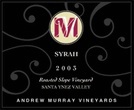
External search
Google (images)
Wine Advocate
Wine Spectator
Burghound
Wine-Searcher
Vintages
2006
2005
2003
2002
2001
2000
1999
1998
1997
From this producer
Show all wines
All tasting notes
|
| Drinking Windows and Values |
| Drinking window: Drink between 2002 and 2007 (based on 12 user opinions) |
| Community Tasting History |
| Community Tasting Notes (average 89 pts. and median of 89 pts. in 2 notes) - hiding notes with no text | | | Tasted by acyso on 3/7/2016 & rated 90 points: The Rotating Dinners, I.1: California Syrah (Chicago, IL): I quite enjoyed this wine -- much more so than many others at the table. This had a touch of barnyard on the nose, as well as lovely dried tart red cherry aromas and flavours. Light and elegant, with plenty of acidity, though the fruit does seem to be on its last legs. (1509 views) | | | Tasted by Nanda on 3/7/2016 & rated 88 points: California Syrah (Webster Wine Bar): Deep dark ruby. Bold nose has concentrated black fruits and major creosote, smoked meat and spice notes. Quite a brooding and impressive nose for an 18 year old wine. On the palate, this has medium weight and fruit concentration that doesn't jive with the bold flavor profile of meat, creosote, smoke, pepper and spice. I need more fruit density to match the assertive flavors. I think I would have liked this wine a lot more in its youth. (1090 views) |
| Andrew Murray Producer websiteSyrah Varietal article (Wikipedia) | (Wines Northwest)
Note that some producers in the Northern Rhone distinguish between simply Syrah and "Serine", the latter described as ‘an ancient clone of Syrah, the berries of which are more oval-shaped and less deeply pigmented than Syrah’ by producer Tardieu-Laurent. USAAmerican wine has been produced since the 1500s, with the first widespread production beginning in New Mexico in 1628. Today, wine production is undertaken in all fifty states, with California producing 84% of all U.S. wine. The continent of North America is home to several native species of grape, including Vitis labrusca, Vitis riparia, Vitis rotundifolia, and Vitis vulpina, but the wine-making industry is based almost entirely on the cultivation of the European Vitis vinifera, which was introduced by European settlers. With more than 1,100,000 acres (4,500 km2) under vine, the United States is the fourth-largest wine producing country in the world, after Italy, Spain, and France.California2021 vintage: "Unlike almost all other areas of the state, the Russian River Valley had higher than normal crops in 2021, which has made for a wine of greater generosity and fruit forwardness than some of its stablemates." - Morgan Twain-Peterson Central Coasthttp://www.ccwinegrowers.org/links.html
http://www.discovercaliforniawines.com/regional-wine-organizations/
http://beveragetradenetwork.com/en/btn-academy/list-of-winegrowers-association-in-central-coast-california-274.htm
Central Coast AVA WikipediaSanta Ynez ValleyThe Santa Ynez Valley AVA is the largest wine sub-region of Santa Barbara County and has the highest concentration of vineyards. The valley runs from east to west, between the Purisima Hills and the San Rafael Mountains in the north, and the Santa Ynez Mountains in the south. Although the valley is open to the Pacific Ocean in the west, the fact that it is relatively narrow means that limited cool air and fog is funnelled in. Low average rainfall and a very long growing season make the region ideal for quality wine production.
The diverse climates of Santa Ynez Valley mean that a wide array of wines is produced. The cool, western part of the AVA is predominantly planted with Pinot Noir and Chardonnay, accompanied by other aromatic white varieties. Botrytis cinerea (noble rot) is able to flourish here, allowing some outstanding dessert wines to be produced in suitable vintages. Further east, the cooling effect of the ocean is lessened as both vineyard elevation and average temperatures increase. This warmer part of Santa Ynez Valley is more suited to fuller-bodied grape varieties, such as Syrah and Merlot.
more ...s expected, Chardonnay and Pinot Noir thrive, while the more inland zones lay claim to Bordeaux varietals and some Rhone blends. |
|


